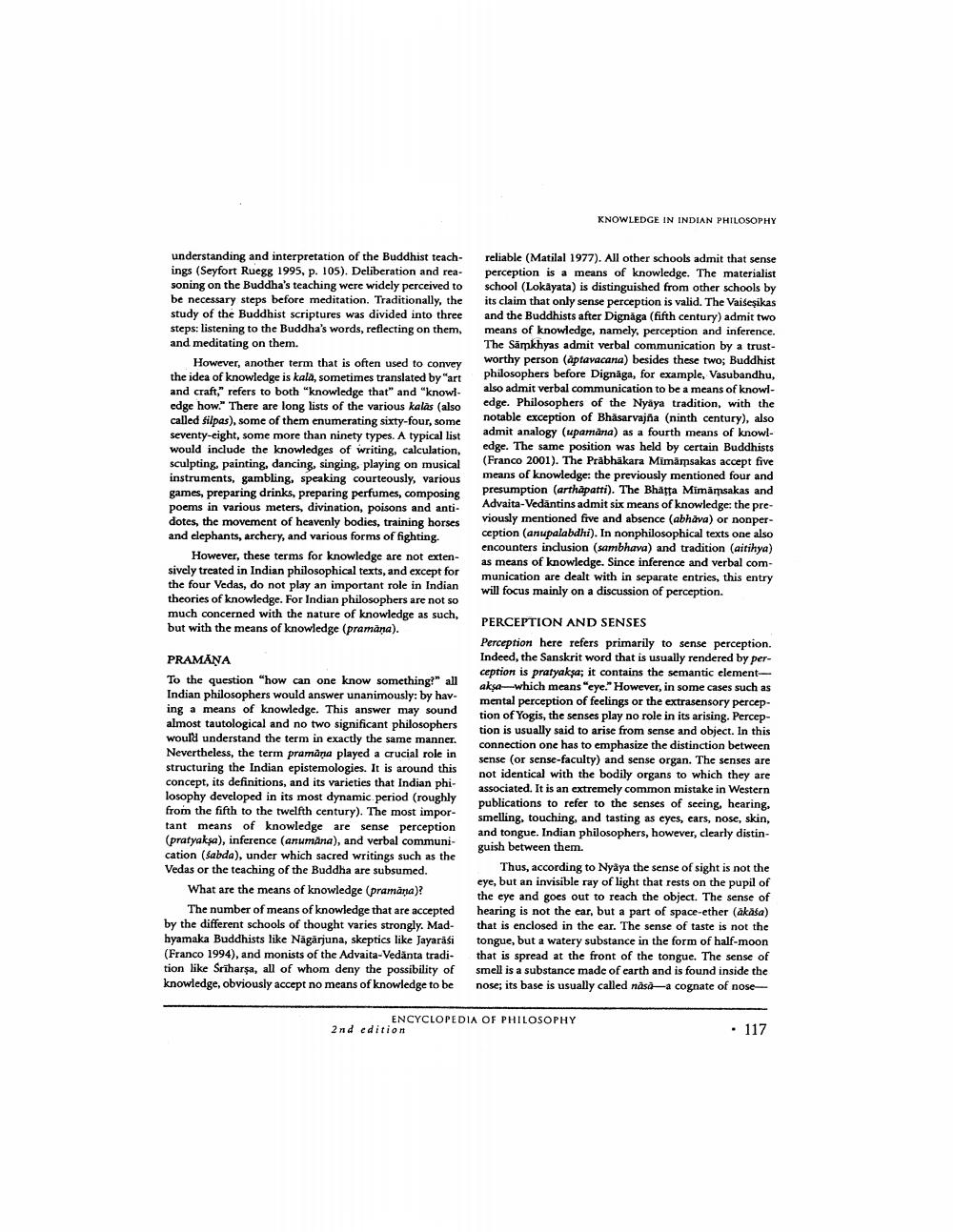Book Title: Knowledge In Indian Philosophy Author(s): Publisher: View full book textPage 3
________________ KNOWLEDGE IN INDIAN PHILOSOPHY understanding and interpretation of the Buddhist teach- ings (Seyfort Ruegg 1995, p. 105). Deliberation and rea- soning on the Buddha's teaching were widely perceived to be necessary steps before meditation. Traditionally, the study of the Buddhist scriptures was divided into three steps: listening to the Buddha's words, reflecting on them, and meditating on them. However, another term that is often used to convey the idea of knowledge is kala, sometimes translated by Cart and craft," refers to both "knowledge that" and "knowledge how." There are long lists of the various kalas (also called silpas), some of them enumerating sixty-four, some seventy-eight, some more than ninety types. A typical list would include the knowledges of writing, calculation, sculpting, painting, dancing, singing, playing on musical instruments, gambling, speaking courteously, various games, preparing drinks, preparing perfumes, composing poems in various meters, divination, poisons and antidotes, the movement of heavenly bodies, training horses and elephants, archery, and various forms of fighting. However, these terms for knowledge are not extensively treated in Indian philosophical texts, and except for the four Vedas, do not play an important role in Indian theories of knowledge. For Indian philosophers are not so much concerned with the nature of knowledge as such, but with the means of knowledge (pramana). reliable (Matilal 1977). All other schools admit that sense perception is a means of knowledge. The materialist school (Lokayata) is distinguished from other schools by its claim that only sense perception is valid. The Vaisesikas and the Buddhists after Dignaga (fifth century) admit two means of knowledge, namely, perception and inference. The Samkhyas admit verbal communication by a trustworthy person (aptavacana) besides these two; Buddhist philosophers before Dignaga, for example, Vasubandhu, also admit verbal communication to be a means of knowledge. Philosophers of the Nyaya tradition, with the notable exception of Bhasarvajna (ninth century), also admit analogy (upamana) as a fourth means of knowledge. The same position was held by certain Buddhists (Franco 2001). The Prabhakara Mimamsakas accept five means of knowledge: the previously mentioned four and presumption (arthapatti). The Bhasta Mimansakas and Advaita-Vedantins admit six means of knowledge: the previously mentioned five and absence (abhava) or nonperception (anupalabdhi). In nonphilosophical texts one also encounters inclusion (sambhava) and tradition (aitihya) as means of knowledge. Since inference and verbal communication are dealt with in separate entries, this entry will focus mainly on a discussion of perception. PRAMANA To the question "how can one know something?" all Indian philosophers would answer unanimously: by having a means of knowledge. This answer may sound almost tautological and no two significant philosophers would understand the term in exactly the same manner. Nevertheless, the term pramana played a crucial role in structuring the Indian epistemologies. It is around this concept, its definitions, and its varieties that Indian philosophy developed in its most dynamic period (roughly from the fifth to the twelfth century). The most important means of knowledge are sense perception (pratyaksa), inference (anumana), and verbal communication (sabda), under which sacred writings such as the Vedas or the teaching of the Buddha are subsumed. What are the means of knowledge (pramana)? The number of means of knowledge that are accepted by the different schools of thought varies strongly. Mad- hyamaka Buddhists like Nagarjuna, skeptics like Jayarasi (Franco 1994), and monists of the Advaita-Vedanta tradi- tion like Sriharsa, all of whom deny the possibility of knowledge, obviously accept no means of knowledge to be PERCEPTION AND SENSES Perception here refers primarily to sense perception. Indeed, the Sanskrit word that is usually rendered by perception is pratyaksa; it contains the semantic elementakse-which means "eye." However, in some cases such as mental perception of feelings or the extrasensory perception of Yogis, the senses play no role in its arising. Perception is usually said to arise from sense and object. In this connection one has to emphasize the distinction between sense (or sense-faculty) and sense organ. The senses are not identical with the bodily organs to which they are associated. It is an extremely common mistake in Western publications to refer to the senses of seeing, hearing, smelling, touching, and tasting as eyes, ears, nose, skin, and tongue. Indian philosophers, however, clearly distinguish between them. Thus, according to Nyaya the sense of sight is not the eye, but an invisible ray of light that rests on the pupil of the eye and goes out to reach the object. The sense of hearing is not the ear, but a part of space-ether (akasa) that is enclosed in the ear. The sense of taste is not the tongue, but a watery substance in the form of half-moon that is spread at the front of the tongue. The sense of smell is a substance made of earth and is found inside the nose; its base is usually called nasaa cognate of nose ENCYCLOPEDIA OF PHILOSOPHY 2nd edition * 117Page Navigation
1 2 3 4 5 6 7 8 9
